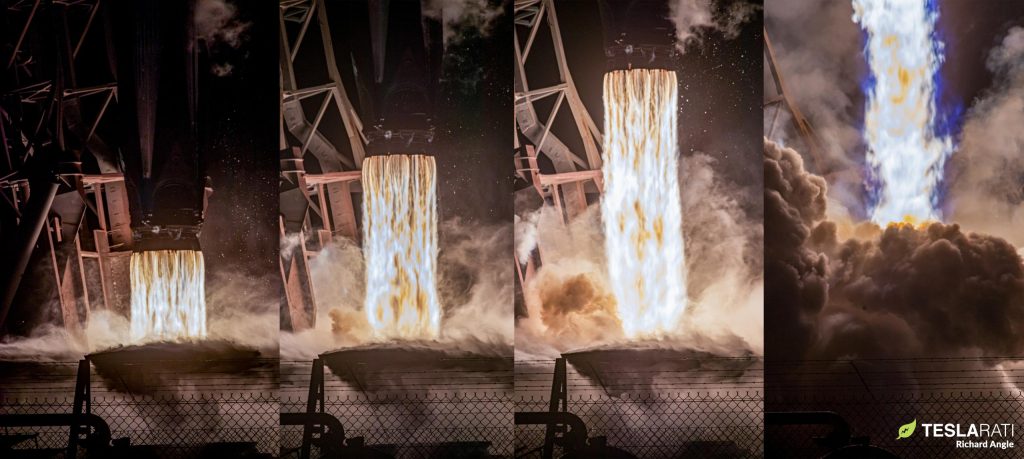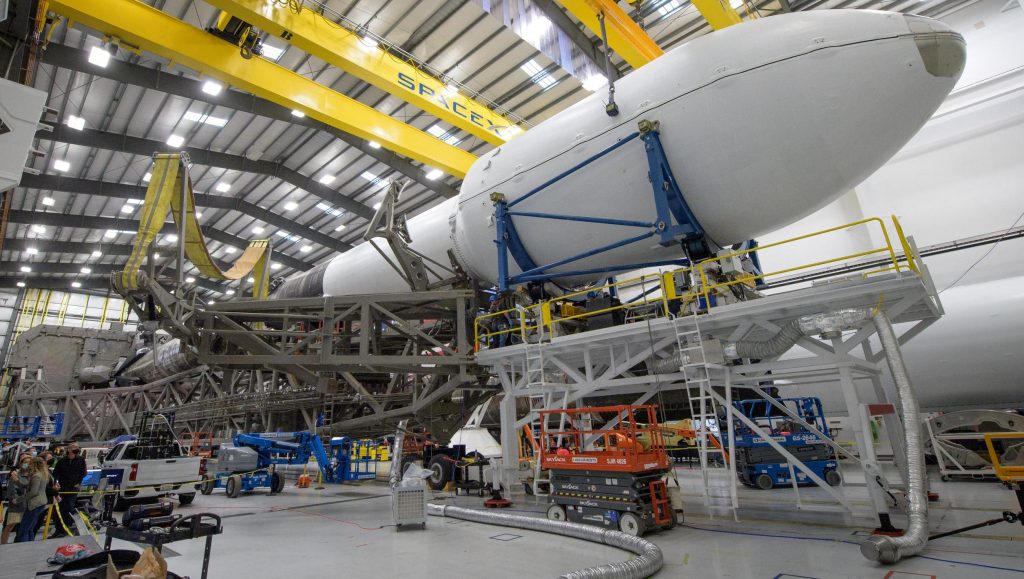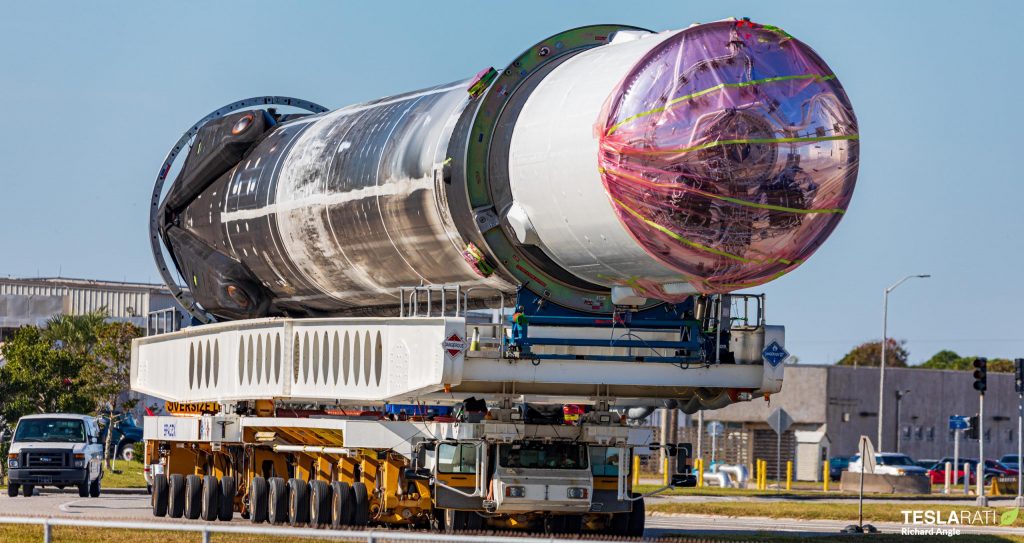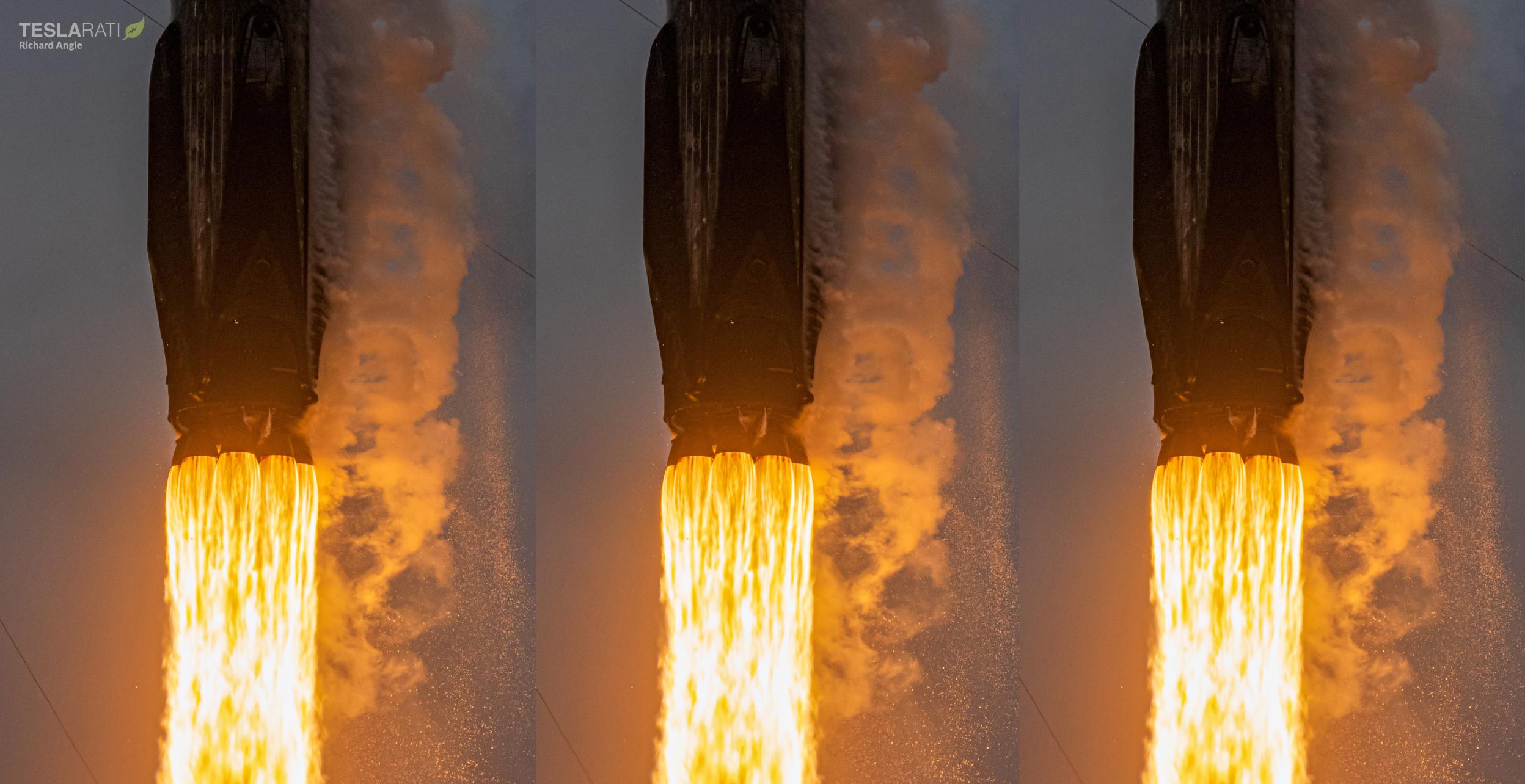Update #2: SpaceX has successfully delivered Starlink 4-4 – batch of 52 new satellites – to low Earth orbit (LEO), completing the first of three back-to-back Falcon 9 launches scheduled less than three days apart.
Starlink 4-4 marks the 98th successful Falcon landing, the first time SpaceX has performed a non-polar Starlink launch from its West Coast pad, and the first time a Falcon 9 booster has completed 11 orbital-class launches and spaceflights. Up next, SpaceX is scheduled to launch Turkey’s Turksat 5B geostationary communications satellite out of its Cape Canaveral, Florida LC-40 pad. Falcon 9 could lift off as early as 10:58 pm EDT, Saturday, December 18th (03:58 UTC 19 Dec) – just 15 hours after Starlink 4-4. Set in September 2021, SpaceX’s current record is two launches in ~44 hours.
Update: SpaceX’s second dedicated West Coast Starlink launch has slipped to no earlier than (NET) 1:24 am PDT (09:24 UTC) on Saturday, December 18th. Headed to an orbit unusual for a Vandenberg Space Force Base launch, Starlink 4-4 could now lift off just 18 hours before a different SpaceX mission – Turksat 5B – lifts off from the opposite side of the country.
Barring delays to Cargo Dragon’s CRS-24 space station resupply mission, which remains scheduled for 5:06 am EDT on December 21st, that means that SpaceX is now on track to launch three Falcon 9 rockets in three days (less than 73 hours).
SpaceX appears to be on track to round out a record-breaking year with three Falcon 9 launches in four days.
With the diverse trio of missions, SpaceX will orbit another batch of laser-linked Starlink satellites, deliver a large communications satellite to geostationary transfer orbit (GTO), send a Dragon to space for sixth time this year, and break at least two company records. The first mission, known as Starlink 2-3, could occur as early as the morning of December 17th, kicking off an incredibly busy period of launches – and not just for SpaceX.

Starlink 2-3
Referring to the fact that the mission will be the third launch for the second distinct group or ‘shell’ of Starlink satellites, Starlink 2-3 will actually be the second dedicated launch to a semi-polar orbit, leapfrogging Starlink 2-2 for unknown reasons after Starlink 2-1’s successful September launch. Originally scheduled to launch in mid-October, SpaceX was forced to stand down just a few days before liftoff for unknown reasons and at least a week or two of delays soon put Starlink 2-3 at risk of clashing with the company’s upcoming NASA DART launch, which unsurprisingly took precedence. SpaceX successfully launched the Double Asteroid Redirection Test (DART) mission on November 24th.
Late on December 13th, tugboat Scorpius likely departed Port of Long Beach with SpaceX drone ship Of Course I Still Love You (OCISLY) in tow – a fairly airtight confirmation that a SpaceX launch is just a handful of days away. Based on safety Notices to Airmen and Mariners (NOTAMs/NOTMARs), Starlink 2-3 is scheduled to launch sometime between 12am and 6am PDT (UTC-8) on Friday, December 17th. If accurate and SpaceX stays on schedule, Falcon 9 could lift off from the company’s Vandenberg SLC-4E launch pad with Starlink 2-3 in tow just 22 days after a different Falcon 9 rocket launched DART – smashing the pad’s current 36-day turnaround record by almost 40%.

Aside from drastically increasing the maximum theoretical launch cadence SpaceX’s West Coast pad is capable of supporting, Starlink 2-3 is also expected – as it was in October – to fly on Falcon 9 booster B1051, potentially making the mission the first time a liquid rocket booster has completed eleven orbital-class launches. B1051 debuted in March 2019, sending an uncrewed Crew Dragon on its way to orbit for the first time. Before SpaceX’s Starlink launch cadence fell off a cliff in the second half of 2021, B1051 completed its tenth launch on May 9th, 2021, averaging one launch every ~80 days over a two-year career. Starlink 2-3 will be B1051’s first launch in 7 months and eleventh launch in 33 months.
Turksat 5B
As early as 11:58 pm EDT (UTC-5) on Saturday, December 18th, another Falcon 9 rocket is scheduled to launch Turkey’s Turksat 5B geostationary communications satellite from SpaceX’s Cape Canaveral LC-40 pad. There’s a good chance that former Falcon Heavy booster B1052 – recently converted into a Falcon 9 after more than two years in storage – will be assigned to the mission, which is set to be SpaceX’s 30th orbital launch in 2021.

CRS-24 and more!
Finally, a different Falcon 9 (possibly B1062 or even a new booster entirely) is scheduled to launch a new Cargo Dragon 2 spacecraft on CRS-24 – potentially the company’s 23rd operational International Space Station (ISS) resupply run since October 2012. It will be Falcon 9’s sixth Dragon launch of 2021 – another record for SpaceX and the spacecraft. If the schedule holds, CRS-24 could lift off as early as 5:06 am EDT (UTC-5) on Tuesday, December 21st and would be SpaceX’s third Falcon 9 launch in roughly 100 hours (a little over four days). CRS-24 is expected to be SpaceX’s 31st and final launch of 2021, beating out the 26-launch record it set just last year.
However, the rest of the world isn’t quite finished. As early as the day after CRS-24, an Ariane 5 rocket is scheduled to launch the almost $10 billion, NASA-built James Webb Space Telescope (JWST). Decades in the making, JWST will be the single most expensive payload and the largest space telescope ever launched and is functionally irreplaceable and hard (but not impossible, if the political will is there) to repair, making it perhaps the most universally nerve-wracking uncrewed launch in the history of spaceflight.
News
Tesla launches in India with Model Y, showing pricing will be biggest challenge
Tesla finally got its Model Y launched in India, but it will surely come at a price for consumers.

Tesla has officially launched in India following years of delays, as it brought its Model Y to the market for the first time on Tuesday.
However, the launch showed that pricing is going to be its biggest challenge. The all-electric Model Y is priced significantly higher than in other major markets in which Tesla operates.
On Tuesday, Tesla’s Model Y went up for sale for 59,89,000 rupees for the Rear-Wheel Drive configuration, while the Long Range Rear-Wheel Drive was priced at 67,89,000.
This equates to $69,686 for the RWD and $78,994 for the Long Range RWD, a substantial markup compared to what these cars sell for in the United States.
🚨 Here’s the difference in price for the Tesla Model Y in the U.S. compared to India.
🚨 59,89,000 is $69,686
🚨 67,89,000 is $78,994 pic.twitter.com/7EUzyWLcED— TESLARATI (@Teslarati) July 15, 2025
Deliveries are currently scheduled for the third quarter, and it will be interesting to see how many units they can sell in the market at this price point.
The price includes tariffs and additional fees that are applied by the Indian government, which has aimed to work with foreign automakers to come to terms on lower duties that increase vehicle cost.
Tesla Model Y seen testing under wraps in India ahead of launch
There is a chance that these duties will be removed, which would create a more stable and affordable pricing model for Tesla in the future. President Trump and Indian Prime Minister Narendra Modi continue to iron out those details.
Maharashtra Chief Minister Devendra Fadnavis said to reporters outside the company’s new outlet in the region (via Reuters):
“In the future, we wish to see R&D and manufacturing done in India, and I am sure at an appropriate stage, Tesla will think about it.”
It appears to be eerily similar to the same “game of chicken” Tesla played with Indian government officials for the past few years. Tesla has always wanted to enter India, but was unable to do so due to these import duties.
India wanted Tesla to commit to building a Gigafactory in the country, but Tesla wanted to test demand first.
It seems this could be that demand test, and the duties are going to have a significant impact on what demand will actually be.
Elon Musk
Tesla ups Robotaxi fare price to another comical figure with service area expansion
Tesla upped its fare price for a Robotaxi ride from $4.20 to, you guessed it, $6.90.

Tesla has upped its fare price for the Robotaxi platform in Austin for the first time since its launch on June 22. The increase came on the same day that Tesla expanded its Service Area for the Robotaxi ride-hailing service, offering rides to a broader portion of the city.
The price is up from $4.20, a figure that many Tesla fans will find amusing, considering CEO Elon Musk has used that number, as well as ’69,’ as a light-hearted attempt at comedy over the past several years.
Musk confirmed yesterday that Tesla would up the price per ride from that $4.20 point to $6.90. Are we really surprised that is what the company decided on, as the expansion of the Service Area also took effect on Monday?
But the price is now a princely $6.90, as foretold in the prophecy 😂
— Elon Musk (@elonmusk) July 14, 2025
The Service Area expansion was also somewhat of a joke too, especially considering the shape of the new region where the driverless service can travel.
I wrote yesterday about how it might be funny, but in reality, it is more of a message to competitors that Tesla can expand in Austin wherever it wants at any time.
Tesla’s Robotaxi expansion wasn’t a joke, it was a warning to competitors
It was only a matter of time before the Robotaxi platform would subject riders to a higher, flat fee for a ride. This is primarily due to two reasons: the size of the access program is increasing, and, more importantly, the service area is expanding in size.
Tesla has already surpassed Waymo in Austin in terms of its service area, which is roughly five square miles larger. Waymo launched driverless rides to the public back in March, while Tesla’s just became available to a small group in June. Tesla has already expanded it, allowing new members to hail a ride from a driverless Model Y nearly every day.
The Robotaxi app is also becoming more robust as Tesla is adding new features with updates. It has already been updated on two occasions, with the most recent improvements being rolled out yesterday.
Tesla updates Robotaxi app with several big changes, including wider service area
News
Tesla Model Y and Model 3 dominate U.S. EV sales despite headwinds
Tesla’s two mainstream vehicles accounted for more than 40% of all EVs sold in the United States in Q2 2025.

Tesla’s Model Y and Model 3 remained the top-selling electric vehicles in the U.S. during Q2 2025, even as the broader EV market dipped 6.3% year-over-year.
The Model Y logged 86,120 units sold, followed by the Model 3 at 48,803. This means that Tesla’s two mainstream vehicles accounted for 43% of all EVs sold in the United States during the second quarter, as per data from Cox Automotive.
Tesla leads amid tax credit uncertainty and a tough first half
Tesla’s performance in Q2 is notable given a series of hurdles earlier in the year. The company temporarily paused Model Y deliveries in Q1 as it transitioned to the production of the new Model Y, and its retail presence was hit by protests and vandalism tied to political backlash against CEO Elon Musk. The fallout carried into Q2, yet Tesla’s two mass-market vehicles still outsold the next eight EVs combined.
Q2 marked just the third-ever YoY decline in quarterly EV sales, totaling 310,839 units. Electric vehicle sales, however, were still up 4.9% from Q1 and reached a record 607,089 units in the first half of 2025. Analysts also expect a surge in Q3 as buyers rush to qualify for federal EV tax credits before they expire on October 1, Cox Automotive noted in a post.
Legacy rivals gain ground, but Tesla holds its commanding lead
General Motors more than doubled its EV volume in the first half of 2025, selling over 78,000 units and boosting its EV market share to 12.9%. Chevrolet became the second-best-selling EV brand, pushing GM past Ford and Hyundai. Tesla, however, still retained a commanding 44.7% electric vehicle market share despite a 12% drop in in Q2 revenue, following a decline of almost 9% in Q1.
Incentives reached record highs in Q2, averaging 14.8% of transaction prices, roughly $8,500 per vehicle. As government support winds down, the used EV market is also gaining momentum, with over 100,000 used EVs sold in Q2.
Q2 2025 Kelley Blue Book EV Sales Report by Simon Alvarez on Scribd
-

 News3 days ago
News3 days agoTesla debuts hands-free Grok AI with update 2025.26: What you need to know
-

 Elon Musk1 week ago
Elon Musk1 week agoElon Musk confirms Grok 4 launch on July 9 with livestream event
-

 Elon Musk6 days ago
Elon Musk6 days agoxAI launches Grok 4 with new $300/month SuperGrok Heavy subscription
-

 News2 weeks ago
News2 weeks agoTesla Model 3 ranks as the safest new car in Europe for 2025, per Euro NCAP tests
-

 Elon Musk2 weeks ago
Elon Musk2 weeks agoxAI’s Memphis data center receives air permit despite community criticism
-

 News5 days ago
News5 days agoTesla begins Robotaxi certification push in Arizona: report
-

 Elon Musk2 weeks ago
Elon Musk2 weeks agoTesla reveals it is using AI to make factories more sustainable: here’s how
-

 Elon Musk2 weeks ago
Elon Musk2 weeks agoTesla scrambles after Musk sidekick exit, CEO takes over sales

















